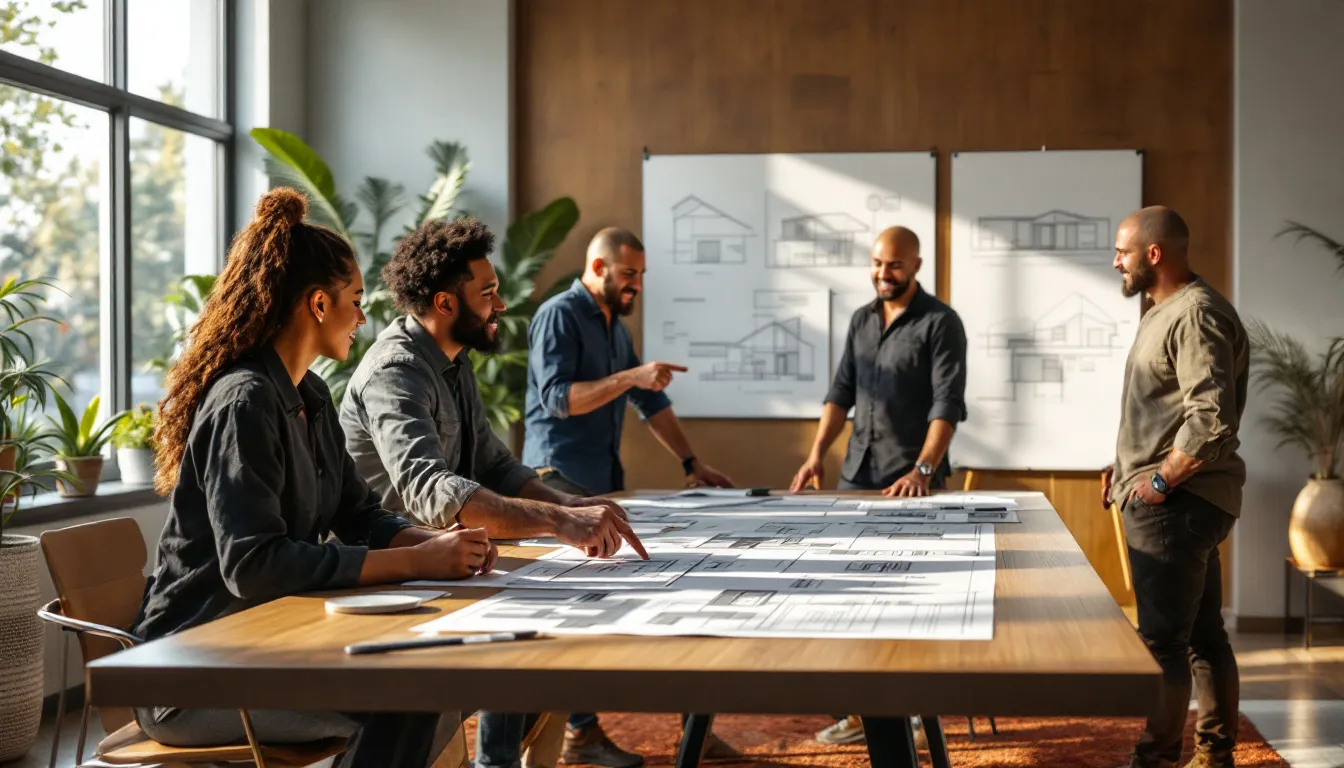Looking to build an Accessory Dwelling Unit (ADU)? Here's what you need to know about permits across the US:
- ADU permits vary widely by state and city
- Key requirements: zoning rules, building codes, utility connections
- Top ADU-friendly states: California, Oregon, Washington
- Emerging ADU markets: Arizona, Texas, Florida
- Permit process typically takes 6-8 weeks
- Common hurdles: incomplete applications, zoning violations, budget surprises
Quick comparison of major ADU states:
| State | Size Limit | Key Features |
|---|---|---|
| California | 150-1,200 sq ft | No min lot size, 60-day permit response |
| Oregon | Max 900 sq ft | 40 ft front setback |
| Washington | Max 1,000 sq ft | Two ADUs allowed per property |
| Connecticut | Max 1,000 sq ft | Local rules may override |
| Maine | 190-900 sq ft | Multiple units allowed |
To get your ADU permit:
- Check local laws
- Draw up plans
- Submit application
- Pay fees (1-2% of build cost)
- Wait for approval
Costs vary, but expect $120K-$400K depending on type and size.
Related video from YouTube
ADU Permits by State
ADU regulations vary across the US. Let's look at permit requirements in major ADU-friendly states and emerging trends in newer supportive regions.
Major ADU States
Some states lead in promoting ADUs through progressive laws and easier permitting. Here's a snapshot of permit rules in top ADU-friendly states:
| State | Key ADU Permit Rules |
|---|---|
| California | No minimum lot size, 150-1,200 sq ft range, 60-day permit response |
| Oregon | Max 900 sq ft for detached ADUs, 40 ft setback from front lot line |
| Washington | Two ADUs allowed per property, max 1,000 sq ft or 60% of main dwelling |
| Connecticut | Max 1,000 sq ft, local ordinances may override |
| Maine | Multiple units allowed, 190-900 sq ft or 35% of main dwelling |
| New York | 200-1,500 sq ft range |
California's a pioneer in ADU laws. Since 2016, they've made ADU construction easier. They've ditched minimum lot size rules and paused owner-occupancy requirements until 2025.
"Government restrictions on supply lead to increased prices", says Duncan Hosie, a writer and lawyer.
Oregon's been ADU-friendly since 1981. Portland's leading the charge with cool perks like waiving some fees for ADUs rented for at least 30 days at a time.
Washington just passed HB 1337, allowing two ADUs on one property. That's a big step towards more housing density.
New ADU-Friendly States
Some states are just starting to embrace ADUs. Here's what's happening in these up-and-coming ADU spots:
Arizona is jumping on the ADU bandwagon. While they're still working on statewide laws, many cities are updating their zoning codes for ADUs.
Texas is a mixed bag. In 2022, they shot down a bill for statewide backyard ADUs. But some cities are taking matters into their own hands:
- Houston's fast-tracking building permits, including ADUs, in about two weeks.
- Austin's updating its ADU rules to boost housing options.
Florida's warming up to ADUs as a housing fix. State laws are limited, but local areas are changing their codes to make ADU construction easier.
The trend? Cities are often leading the charge, even when state laws lag behind.
If you're thinking about building an ADU, know your local rules. In Texas, for example, start with state laws on ADU definitions and occupancy limits. Then dig into local zoning rules. And don't forget to chat with pros like architects and contractors. They'll help you navigate the ADU building process like a pro.
Main Permit Requirements
Getting an ADU permit isn't a walk in the park. You'll need to navigate zoning laws, building codes, and utility connections. Here's what you need to know:
Zoning Rules
Zoning rules set the boundaries for your ADU project. They decide where and what you can build:
| Zoning Aspect | Typical Requirements |
|---|---|
| Size Limits | 500-1,200 sq ft (location-dependent) |
| Setbacks | Usually 5-10 ft from property lines |
| Height Restrictions | Often max 16-24 ft |
| Parking | Might need 1 extra space |
Some cities are more ADU-friendly than others. San Francisco allows ADUs up to 1,200 sq ft, while San Diego caps them at 1,200 sq ft or 50% of the main house, whichever is less.
Building Permits and Plans
Time for paperwork. You'll need to submit detailed plans for approval. Here's what you'll typically need:
- ADU Permit Application Form
- Proof you own the property
- Site plans (current and proposed)
- Detailed construction plans
- Title 24 Residential Energy Calculations
- Cal-Green Checklist
"From submission to permit, the ADU process usually takes 6-8 weeks, depending on where you live", says a California ADU expert.
Working with an experienced architect can save you a lot of trouble. They know the local codes like the back of their hand.
Utilities and Fees
Connecting utilities and understanding costs is key. Here's a rough breakdown:
| Item | Estimated Cost |
|---|---|
| Utility Connections | $2,000 |
| Utility Trenching | $3,000 - $7,000 |
| Solar Panels (if needed) | $12,000 - $17,000 |
| Electrical Panel Upgrade | $2,000 |
Permit costs vary widely. In Los Angeles:
- Small ADU (~300 sq ft): ~$1,840
- Large ADU (1,200 sq ft): ~$7,922
Don't forget impact fees. These can add thousands to your budget, depending on where you live.
Some cities offer fee waivers for ADUs. Portland, for example, waives some fees for ADUs rented for at least 30 days at a time. Check if your city has similar deals.
Navigating these requirements can be tough, but it's worth it. As Duncan Hosie, a writer and lawyer, puts it: "Government restrictions on supply lead to increased prices." By building an ADU, you're not just boosting your property value – you're helping solve the housing shortage.
sbb-itb-4e754d1
How to Find ADU Builders
Finding the right ADU builder can make or break your project. Here's how to do it:
THE BEST ADU BUILDERS

THE BEST ADU BUILDERS is a great starting point. It's an online platform that connects you with ADU builders across the US. Here's the process:
- Tell them about your project
- Get matched with local builders
- Check out builder profiles
But don't stop there. Let's dive deeper into finding your perfect ADU builder.
Do Your Homework
Look for builders who know their ADU stuff. Check out these top performers from 2023:
| Builder | Projects Completed | Avg. Contract Value |
|---|---|---|
| Green Tech Remodeling & Design Inc | 9 | $10,000 |
| Potato Construction Inc | 8 | $180,000 |
| MLC Construction Inc. | 7 | $54,000 |
| Trig Builders | 7 | $18,000 |
Check Their Creds
Make sure your builder is legit:
- Got a license? In California, you need a B-license to build ADUs.
- Show me the goods. Ask for photos of finished ADUs. Green Tech Remodeling & Design Inc did a $65,000 one-story addition in 2024.
- What are people saying? Yelp and Google Reviews can spill the tea.
Shop Around
Don't jump at the first offer. Get at least three quotes. Here's what some builders have done:
- MLC Construction Inc. built a 1,200 square foot detached ADU for $200,000 in 2023.
- Trig Builders turned a garage into an ADU for $50,000.
Talk It Out
Meet your potential builders face-to-face. Ask them:
- How do you design?
- Know the local ADU rules?
- How long will this take?
- See any potential roadblocks?
Call Their References
This step is a MUST. Call three references for each builder you're eyeing. Ask:
- Did they finish on time?
- Stick to the budget?
- How was the communication?
- Any surprises along the way?
Steps to Get Your Permit
Getting an ADU permit can be tricky. But don't worry - we've got you covered. Here's how to make it happen:
Meeting with City Officials
First things first: talk to your local authorities. It's a smart move that can save you time and hassle.
Why? You'll:
- Get the lowdown on what you need
- Spot potential issues early
- Build a good relationship with the decision-makers
"Talking to local authorities can really speed up your ADU approval", says a California ADU expert.
Pro tip: Set up a meeting with your city's planning department before you apply. Come ready to ask about zoning, setbacks, and any new ADU rules.
Paperwork and Wait Times
After chatting with the city, it's paperwork time. Here's what you'll usually need:
| Document | What it's for |
|---|---|
| ADU Permit Application | Your official ask for approval |
| Proof You Own the Property | Shows you can build there |
| Site Plans | Maps of your property now and after |
| Construction Plans | Details of your ADU design |
| Title 24 Energy Calculations | Proves it's energy-efficient |
| Cal-Green Checklist | Shows it meets green building rules |
How long will you wait? It depends:
- San José: 20 business days for first look
- Inglewood: 6-8 weeks total
- Danville: 4-6 weeks if you use their fast-track
- Calistoga: Super quick 30-day turnaround
"Usually, it takes 6-8 weeks from start to finish, depending on where you live", a California ADU expert tells us.
Heads up: Some cities are faster than others. San Jose, for example, might approve pre-approved ADU designs on the same day. That could save you months!
Common Problems and Solutions
Even with good planning, you might hit some snags. Here are the usual suspects and how to beat them:
1. Incomplete Applications
The issue: Missing stuff, especially that water flow letter from your water company.
The fix: Get in touch with your water company early. Don't let this hold you up.
2. Zoning Violations
The issue: Getting the math wrong on lot coverage or forgetting about setbacks.
The fix: Team up with an architect who knows local ADU laws. For example, Further Out Group checks zoning and measures on-site before drawing up plans.
3. Budget Surprises
The issue: Costs you didn't see coming that throw off your whole project.
The fix: Plan for extra expenses. Remember:
- Pros like architects and engineers? About 10% of building costs.
- City fees? 6% to 9% of building costs.
- Turning a garage into an ADU? At least $3,000 for plan review and permits in some places.
4. Long Review Times
The issue: Having to redo plans over and over, which takes forever.
The fix: Get it right the first time. Submit plans that are spot-on and complete. If your area offers pre-approved ADU plans, think about using those to speed things up.
Summary
Adding an ADU to your property can be tricky, but it's doable with the right info and approach. Here's what you need to know:
State Rules Differ
ADU laws aren't the same everywhere. Check out these examples:
| State | ADU Rules |
|---|---|
| California | No lot size minimum, up to 1,200 sq ft, 60-day permit response |
| Oregon | Detached ADUs max 900 sq ft, 40 ft front setback |
| Washington | Two ADUs per property, max 1,000 sq ft |
What Most Places Want
While details vary, you'll usually need to:
- Follow zoning rules (size, setbacks, height)
- Get building permits and detailed plans
- Sort out utilities and pay impact fees
Getting Your Permit
1. Know your local ADU laws
2. Draw up site plans
3. Submit your application
4. Pay fees (usually 1-2% of building cost)
5. Wait for approval (about 6-8 weeks)
Money Matters
ADUs aren't cheap. Here's a rough idea:
| ADU Type | Cost Range |
|---|---|
| Garage Conversion | $120,000 - $180,000 |
| New Build | $200,000 - $400,000 |
| Per Square Foot | $400 - $600 |
Make It Easier
Want a smoother ADU journey? Try these:
- Use pre-approved plans if you can
- Talk to local planners early on
- Work with ADU pros
"From start to finish, getting an ADU permit usually takes 6-8 weeks, depending on where you live", says a California ADU expert.
FAQs
What states are best for ADUs?
States with progressive laws and supportive regulations are the best for ADUs. Here's a quick look:
California is the most ADU-friendly, allowing units up to 1,200 sq ft. Oregon permits ADUs up to 900 sq ft or 75% of the main home. Washington lets you have two ADUs per property. Maine offers flexible size limits and allows multiple units. Connecticut green-lights ADUs up to 1,000 sq ft. New York is catching up with emerging ADU-friendly policies.
California's the big winner here. They've handed out over 80,000 ADU permits since 2016. Their forward-thinking laws have made them the go-to example for ADU development across the country.
Which states have ADU legislation?
ADU laws aren't the same everywhere in the U.S. Here's a quick rundown:
California's been leading the charge since 1982. Oregon's been ADU-friendly since 1981. Washington just passed a law allowing two ADUs per property. Maine's got flexible ADU rules. Connecticut allows ADUs statewide. New York's working on new ADU policies.
But here's the thing: even if a state doesn't have specific ADU laws, some cities are taking matters into their own hands. Take Houston, Texas, for example. They're speeding up ADU permits, even though Texas doesn't have statewide ADU laws.
What are the new laws for ADU in California in 2024?
California's still pushing the envelope with ADU-friendly laws. Here's what's new for 2024:
You can now add two more units to your lot: one ADU up to 1,200 square feet and one Junior ADU up to 500 square feet. They've also ditched minimum lot size requirements and owner-occupancy rules for ADUs permitted before January 1, 2025.
Local agencies now have to approve or deny ADU applications within 60 days. And if you're worried about costs, the California Housing Finance Agency is offering a $40,000 grant to help with ADU development.
"The big changes? A clearer 60-day rule, looser height restrictions, and more clarity on front setback rules", says a Real Estate Expert.
These changes are all about making ADU construction easier and more affordable. If you play your cards right with size and setback requirements, you could turn your single-family lot into a triplex.

